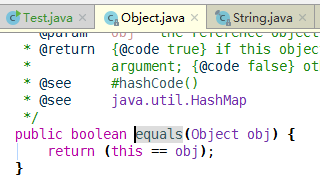开始本文之前,先让我们记住一个口诀(这个口诀只针对基础的类比如String、Integer等,如果是自定义的类,需要看equal的具体实现):
equal比较其值,== 比较地址
这两天在走查代码的时候发现一个童鞋,在判断两个Integer类型的值是否相等的时候,用了==来判断,运行结果没错,因为这两个值在-128~127之间。 只是这种写法不符合规范,有隐患,我不是挑刺,但是觉得有必要给出个所以然来为啥要按照规范使用equal来比较对象值是否相等。
让我们先来看个笔试的例子:请问写出下面的代码输出结果。
public class JavaTest {public static void main(String args[]){Integer a = 127;Integer b = 127;Integer c = new Integer(127);Integer d = new Integer(127);int e = 127;// 1System.out.println(a == b);// 2System.out.println(a.equals(b));// 3System.out.println(a == c);// 4System.out.println(a.equals(c));// 5System.out.println(a == e);// 6System.out.println(a.equals(e));a = 200;b = 200;// 7System.out.println(a == b);// 8System.out.println(a.equals(b));}
}
答案是:
truetruefalsetruetruetruefalsetrue
运用口诀:equal比较其值,==比较地址
第12行输出:true;因为它们的引用地址是同一个,这个地址存的值是127。
第14行输出:true;因为它们的值都是127,所以equal比较其值,结果是相等。
第16行输出:false;因为它们两个对象的引用地址不一样。
第18行输出:true;同上面的第2处。
第20行输出:true;这里会把e做装箱操作(从基本类型提升为包装对象类型),之后它们的引用地址是同一个,同第1处,后面解析java装箱、拆箱的概念。
第22行输出:true;此处一样会对e装箱提升为Integer对象,然后它们的值都是127,所以equal结果为true。
第28行输出:false;因为它们的引用地址不一样,它们不一样~,跟第1处不一样…下面会讲解。
第30行输出:true;因为它们的值都是200,同前面第2、4、6。
- 前面讲到java自动装箱、拆箱 ,简单点说,装箱就是把基本类型升级为对象包装类型;拆箱就是把对象包装类型转换为对应的基本类型。
会自动拆箱、装箱的数据类型为:
| 对象类型 | 基本类型 |
|---|---|
| Integer | int (4字节) |
| Short | short (2字节) |
| Float | float (4字节) |
| Double | double (8字节) |
| Byte | byte (1字节) |
| Long | long (8字节) |
| Character | char (2字节) |
| Boolean | boolean (未定) |
下面让我们来看下具体的装箱、拆箱过程:我们编写一个Test类文件保存在Test.java文件中,UTF-8编码存储,内容如下:
public class Test{public static void main(String[] args) {// 装箱Integer numInteger = 120;// 拆箱int num_int = numInteger;}
}
我们编译一下:
javac Test.java
如果提示“GBK编码…”之类的错误,在指令加个编码选项:
javac -encoding utf-8 Test.java
然后会在当前目录生成一个Test.class文件,我们通过javap工具反汇编看下这个class的内容:
javap指令这里就不展开了,感兴趣的可以看文档:Javap官方文档
javap -c Test.class
上面的指令会直接显示反编译的内容,或者你也可以通过下面的指令来把反汇编的内容输出到文件中,比如输出当前目录的Test.bin文件里面:
javap -c Test.class>Test.bin
反汇编的内容如下:
Compiled from "Test.java"
public class Test {public Test();Code:0: aload_01: invokespecial #1 // Method java/lang/Object."<init>":()V4: returnpublic static void main(java.lang.String[]);Code:0: bipush 1202: invokestatic #2 // Method java/lang/Integer.valueOf:(I)Ljava/lang/Integer;5: astore_16: aload_17: invokevirtual #3 // Method java/lang/Integer.intValue:()I10: istore_211: return
}执行第6行代码Integer numInteger = 120;时,系统底层是执行了Integer.valueOf 来把数值120转换为一个新的Integer包装对象类型。
执行第9行代码int num_int = numInteger;的时候,系统底层实际是执行了Integer.intValue 来把包装对象numInteger的intValue值取出来赋值给int类型变量num_int:
- 那前面的JavaTest类中第12行跟28行的结果为啥不一样?
Integer a = 127;
Integer b = 127;// 1、结果为true
System.out.println(a == b);a = 200;
b = 200;// 7、结果为false
System.out.println(a == b);感觉有点坑吧?我觉得出这个题目的考官是不是有点刁钻呀… 这个并没有啥神秘的,我们直接看源码吧。
当代码中第1处的括号运算:a == b的时候 ,根据口诀,是判断这两个包装对象的地址是否一样,根据上面的反汇编代码可以看出来,代码中的Integer a = 127;对应的操作是Integer a = Integer.valueOf (127); Integer类的源码的valueOf如下:
public final class Integer extends Number implements Comparable<Integer> {// ....../*** Cache to support the object identity semantics of autoboxing for values between* -128 and 127 (inclusive) as required by JLS.** The cache is initialized on first usage. The size of the cache* may be controlled by the {@code -XX:AutoBoxCacheMax=<size>} option.* During VM initialization, java.lang.Integer.IntegerCache.high property* may be set and saved in the private system properties in the* sun.misc.VM class.*/private static class IntegerCache {static final int low = -128;static final int high;static final Integer cache[];static {// high value may be configured by propertyint h = 127;String integerCacheHighPropValue =sun.misc.VM.getSavedProperty("java.lang.Integer.IntegerCache.high");if (integerCacheHighPropValue != null) {try {int i = parseInt(integerCacheHighPropValue);i = Math.max(i, 127);// Maximum array size is Integer.MAX_VALUEh = Math.min(i, Integer.MAX_VALUE - (-low) -1);} catch( NumberFormatException nfe) {// If the property cannot be parsed into an int, ignore it.}}high = h;cache = new Integer[(high - low) + 1];int j = low;for(int k = 0; k < cache.length; k++)cache[k] = new Integer(j++);// range [-128, 127] must be interned (JLS7 5.1.7)assert IntegerCache.high >= 127;}private IntegerCache() {}}/*** Returns an {@code Integer} instance representing the specified* {@code int} value. If a new {@code Integer} instance is not* required, this method should generally be used in preference to* the constructor {@link #Integer(int)}, as this method is likely* to yield significantly better space and time performance by* caching frequently requested values.** This method will always cache values in the range -128 to 127,* inclusive, and may cache other values outside of this range.** @param i an {@code int} value.* @return an {@code Integer} instance representing {@code i}.* @since 1.5*/public static Integer valueOf(int i) {if (i >= IntegerCache.low && i <= IntegerCache.high)return IntegerCache.cache[i + (-IntegerCache.low)];return new Integer(i);}// ......
}
从上面的源码可以看出来,对于-128 ~ 127之间(闭包)的int值,通过valueOf得到其对应的Integer对象,是已经预先静态生成好的存放在数组中的对象,所以只要这个int值是在这区间范围的,得到的对象都是同一个。而如果传过来的int值不在 -128 ~ 127 区间范围,直接在最后new 一个新的Integer对象返回的,这就解释了为啥两个自动装箱数值为200的对象,用==来判断其地址,是不一样的,因为两个对象都不一样了。
这里JDK应该是对于这些1字节长度的数值,总共28 = 256个,从-128~127,预先存起来,加快包装的速度、节省存储空间。那为啥不把两个字节、三个字节的都预先存起来呢?who knows?… 那为啥不把float、double的值也存起来?这两种类型的区间数是无限的好吗,看官你别逗了…
综上所述:
==对于基本类型的数值,是比较它们的值是否相等;对于包装对象这种引用型的变量,比较的是它们在堆中存储的地址是否相同。equals表示这两个变量的value数值是否相同。
如果是自定义的类调用equal,这个需要具体看此类的equal有没有重写,具体如何实现的,比如:
public class Test extends Object{int num = 0;public Test(int i){this.num = i;}public static void main(String[] args) {Test t1 = new Test(1);Test t2 = new Test(1);System.err.println(t1.equals(t2));System.err.println(t1 == t2);}
}
上面的程序执行输出为:
false
false
第二个是false,这个很容易理解,但是第一个为啥呢,不是说好了equal是比较值么?但是这个Test自定义类并没有重写equal方法,所以调用的是Object里面的equal,我们看下它的源码:
也就是,Object的equal实现默认还是通过 == 来实现的… 明白了吧,所以我们自己来实现equal如下:
public class Test extends Object{int num = 0;public Test(int i){this.num = i;}@Overridepublic boolean equals(Object obj) {if(!(obj instanceof Test) || null == obj){return false;}return (num == ((Test) obj).num);}public static void main(String[] args) {Test t1 = new Test(1);Test t2 = new Test(1);System.err.println(t1.equals(t2));System.err.println(t1 == t2);}
}
这样,就能实现equal比较的是值了,跟前面的口诀保持一致了。











:如何研究alpha因子)
团队作业)


题解)


)
